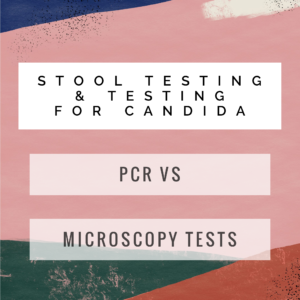Stool testing for dysbiosis & Candida overgrowth
While the entire topic of dysbiosis, Candida overgrowth, signs, symptoms, risk factors & treatments is heavily nuanced, the diagnosis of overgrowth of Candida in the gut is straight forward: stool testing.

The problem with blood tests
Blood tests (IgG, IgA) are NOT diagnostic for current overgrowth of Candida albicans. They show that 1) your immune system has been exposed to Candida and 2) your immune system has created long-term antibodies against Candida. In other words, your immune system knows how to fight Candida.
IgG tests do not reflect current burden, nor are the correlated with symptoms intensity. This is ditto for IgG food testing, but that is an entire separate conversation.
Bottom line: please, please do not use blood tests to diagnose Candida, because they are non-diagnostic.
If you see a doctor and they run blood tests without running a stool test as well for diagnosis, and they tell you that you have Candida, they are giving you bad information. Philosophically and ethically I have enormous issue with this, and it was one of the main motivating factors that finally made me sit at my desk and create this for you.
Other random things – looking at the tongue, spitting into a glass of water & watching what your saliva does, taking online questionnaires — all of these are non-diagnostic for Candida overgrowth in the gut. While competent health care providers can diagnose oral thrush by looking in the mouth, oral thrush does not equal Candida in the gut. Questionnaires can be helpful for organizing your symptoms and your thoughts and pointing you in a direction for further explanation, but they are not diagnostic.
Now that we have that out of the way, let’s talk about stool testing.
Culture vs PCR stool testing
There are two types of stool tests available.
Culture-based stool testing
Once collected from you, culture-type stool tests grow out the different types of bacteria and yeast in the gut. Some of these culture-based stool tests will also examine the stool under the microscope to look for parasites. Based on what grows out and based on what is seen under the microscope – you get your report.
The issue with these types of stool test is the preservative medium. Some companies use a cheap broth that favors the growth of certain types of bacteria (mostly oxygen loving ones). This immediately corrupts the integrity of the sample because it does not reflect what is present in what amounts in your stool in real time, but merely what organisms are able to capitalize on the medium.
What’s more, there are big differences in the rates & requirements of growth of these microorganisms, not to mention the interdependence of different species for growth, all of which is unlikely to be accurately captured in a culture-based test.
Another issue is that not all pathogenic organisms (certainly not all parasites) are shed into every single bowel movement you have. If they are not present in the stool, they certainly are not going to be seen under the microscope. But if they’re not shedding because they’re firmly adhered to the gut wall, how can we know if if they are present? We can’t. And that is a major weakness of culture-and-micrsoscopy based stool testing (you ever hear of O & P tests? Microscopy for the ova/eggs & bodies of parasites. These tests have severe limitations unless you have a rampant parasitic infection).
An advantage of culture-based stool testing is that sensitivity tests can be run on pathogenic organisms found. Some companies offer “culture and sensitivity” aka: C & S testing to determine what antimicrobials will be effective against the pathogens, and what won’t.
However, when it comes specifically to Candida albicans infection, there are a number of substances effective at killing them, so I am more interested in uncovering overgrowth than the C & S aspect of culture-based testing.
For that reason, for Candida overgrowth diagnosis, I like PCR testing. I use culture-based testing frequently in my clinic, however, for casting a wide net and looking at dysbiosis. I use the company Genova Diagnostics.
PCR testing
In this stool test, once the sample is collected it is analyzed using PCR – polymerase chain reaction. This is a molecular probe that illuminates the DNA of microorganisms present in the gut. This means that even if the bodies of bacteria, yeast, fungus or parasites are not present in the stool itself, the test will still be able to detect them, because all organisms (including us) are constantly shedding their DNA.
Thus, PCR testing is much more sensitive and accurate for identifying all pathogens, and most specifically parasites. I think PCR testing is more accurate for Candida burden as well, because Candida can overgrow in some of the broths and conditions used in culture-based testing.
The two disadvantages of PCR testing are the cost and the lack of a C & S component. A full analysis of the microbiome is almost $400 (about $100 more than a culture-based equivalent), while a look just for pathogens is $150. When it comes to dysbiosis, though, you really want the full picture, because your issue could be too few of the good guys!
In terms of Candida overgrowth, the lack of C & S component to PCR testing is not a deal breaker, because we have a very good idea of what pharmaceutical and natural substances kill Candida.
Thus, I am satisfied that when comparing culture-based and PCR testing for Candida overgrowth specifically, PCR testing is the superior option.
The test that I use in my clinic is the GI-MAP test by Diagnostic Solutions Library. The GI-MAP test is also what is used in the Dysbiosis Detector – available until Monday, June 10th at midnight EST


